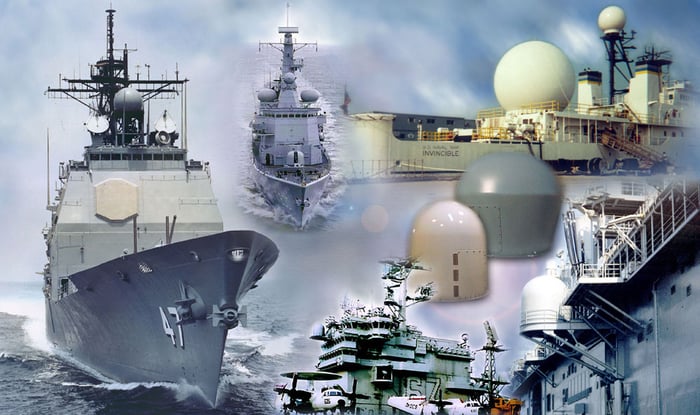Harris Corp. (LHX 0.27%) and L3 Technologies (LLL), two of the most underappreciated companies in the defense sector, are planning to come together in hopes of better competing against the much larger primes. There was a lot for investors to like about each of these companies prior to the deal. Post-merger, the new L3 Harris Technologies looks like it could be a winner.
On Oct. 14, Harris and L3 said they would combine in an all-stock deal that would create a $33.5 billion market cap defense electronics company with about $16 billion in pro forma annual revenue and EBIT of $2.4 billion. L3 CEO Chris Kubasik said the deal would move the two companies closer to becoming an "innovative non-traditional 6th Prime," though the company would still fall well short of industry leaders Lockheed Martin, General Dynamics, Northrop Grumman, Raytheon, and Boeing in terms of annual sales.

IMAGE SOURCE: L-3 TECHNOLOGIES.
Though Harris holders would own a slight majority of the shares in the combined company, the deal is structured as a merger of equals. Post-deal, the board would consist of six members from each side, and Harris CEO William Brown plans to stay in that role for two years before making way for Kubasik.
Can 1 + 1 = 2+?
The two companies are a lot alike, with each focused on military electronics and communications. Both have been pushing to increase the amount of business they do directly with the Pentagon instead of serving as a subcontractor, with Harris focused on battlefield management, aircraft communications, and increasing its classified space work and L3 making a range of sensors and night-vision equipment and developing unmanned vessels.
They both have customers adjacent to the military, with Harris perhaps best known for its Stingray cellphone trackers used by U.S. law enforcement and L3 the vendor behind the full-body scanners used for airport security.
The combined company would generate about 67% of revenue from prime contracts, with the rest from subcontractor work. The U.S. Air Force, the combination's largest customer, would account for just 26% of revenue, with international, U.S. Navy, U.S. Army, commercial work, and civil government agencies each accounting for more than 10%.

Image source: Harris/L3 joint presentation.
Harris' Brown said the deal "unlocks additional growth opportunities" by allowing the combination to offer more end-to-end solutions to a broader range of U.S. and international customers. It also creates the scale needed to pursue bigger opportunities and, hopefully, make combined operations more cost competitive, with the companies predicting at least $500 million in annual gross cost synergies.
They also expect to generate $3 billion in free cash flow within three years.
It can be dangerous to take corporate synergy predictions at face value, but Harris has done well to extract more than $200 million in gross costs out of Exelis, which it bought in 2015, and should have similar opportunities here to not just to combine back-office and public company functions but also streamline similar facilities.
What's next
The deal continues a pattern of large-scale consolidation among government contractors. Last year, Northrop Grumman paid more than $9 billion for Orbital ATK, expanding its exposure to space, and United Technologies agreed to buy Rockwell Collins for more than $30 billion.
So far in 2018, General Dynamics bought government IT contractor CSRA for $7.2 billion, Science Applications International has agreed to buy Engility Holdings for $2.5 billion, and just last week TransDigm agreed to buy Esterline Technologies for $4 billion.
More deals could follow. Analyst attention after the Harris/L3 announcement turned to Textron (TXT 1.70%), a multi-industry conglomerate active in aerospace via its Bell helicopter and aircraft division and through its work on unmanned systems, electronics, and military land vehicles. The company has been pressured at times to spin off some of its military-focused operations and could attract significant interest if it put some or all its aerospace operations on the block.
CACI International and ManTech International, two of the few remaining companies in a rapidly shrinking middle tier in the government contractor sector, are both believed to be on the prowl. CACI bid for both CSRA and Engility.
Is the new company a buy?
Across the corporate landscape, more often than not, mergers seem to go awry, and these companies, if nothing else, will be distracted until the deal closes in mid-2019 and for some time after as the integration plan is executed. That said, I have high hopes for this merger and the new L3 Harris.
Prior to the deal, these were two of the defense sector's more intriguing buys, and their portfolios are complementary enough that it is a wonder they didn't move toward a combination sooner. Brown has earned a reputation as a strong operator at Harris, and Kubasik, the one-time COO and heir apparent at Lockheed Martin, is a well-respected leader who has done well during his first year at the helm at L3.
L3, carved out in the late 1990s from Lockheed Martin, has been discussed for more than a decade as a potential sixth prime. Post-merger, L3 Harris would have the portfolio to compete for business in areas like communications, sensors, and space, which are expected to see an outsize share of future Pentagon spending.
Mergers inherently come with risk, but this is a deal worth buying into.




